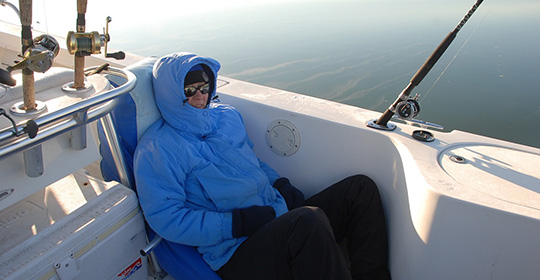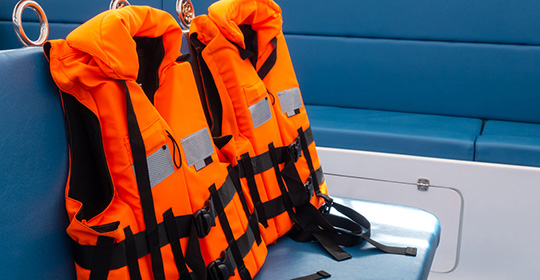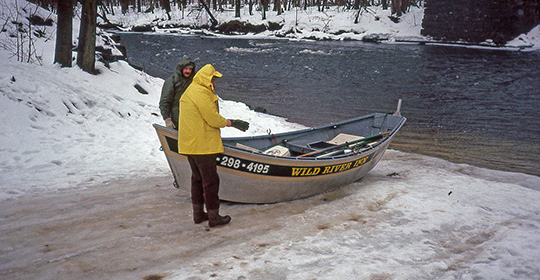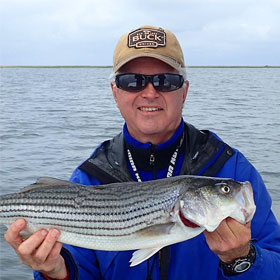35 Water Safety, Fishing, and Boating Tips for January
By Ken Schultz
Jan 10, 2024
Clothes, rods, gear, boats, and assorted practicalities are the focus of these many water safety, fishing, and boating tips for January
I’m sure someone is reading this blog headline and thinking, why do you need so many winter boating tips for? Just be careful and don’t do anything stupid.
That’s it in a nutshell, but fishing and boating circumstances vary considerably depending on your geographic location, the type of water body you venture on, the type of watercraft you have, and so on. Not to mention that problems in January could be more life threatening than at other times. So, while we’re offering a lot of water safety, fishing, and boating tips for January here, not every one will apply wherever you do your fishing and boating.
COMFORT

1. Remember that in winter overdressing is better than underdressing.
2. Always dress appropriate to both the air temperature and the water temperature, since hypothermia is a real concern.
3. Layer your inner clothing.
4. Wear windproof and waterproof outerwear (jacket and bibs).
5. Wear a float suit or survival suit in the most extreme boating in cold weather circumstances.
6. Carry two pairs of gloves, one insulated for maximum warmth.
7. Have disposable packet hand warmers to put in your gloves, if needed.
8. Insulated waterproof footwear is necessary in the coldest conditions.
9. Have disposable packet foot warmers to put on the soles of your thermal socks, if needed.
10. Use battery-operated foot warmers for your boots in the coldest conditions or if your feet are especially sensitive to the cold.
11. Wear a warm beanie, ski cap, or trapper hat, maybe over a brimmed cap and under a jacket hood.
12. Face protection may be necessary depending on conditions and the speed your boat travels; this includes goggles, balaclava, and neck/face buff.
13. If you’re a passenger on a fast-moving boat, face the stern.
SAFETY

1. While wearing a PFD in winter is mandatory in a few localities, even if it’s not, keeping a a PFD on while in the boat is first among boating tips for January.
2. Make sure the PFD fits properly, given that you may have bulky clothing on.
3. Absolutely no alcohol consumption or recreational drugs for anyone onboard.
4. Watch your step: look for ice on docks, ramps, and boat surfaces, especially in the morning.
5. Make sure you have all the U.S. Coast Guard-required boat safety equipment; especially check for operable signaling devices, particularly flares.
6. Have a VHF radio with you (cell phones don’t get a signal everywhere) to summon help if needed, since fewer winter boaters means less chance of getting passerby help.
7. Keep boat speed down for comfort and safety reasons.
8. Always attach the lanyard for the ignition safety cutoff switch to your body while operating the engine.
9. Be especially vigilant to watch for obstructions in the water; winter is the least preferable time for a collision and boat breakdown.
10. Don’t take risks; always consider what would happen if things went wrong and you had to spend a long time afloat (or in the water) until help arrived.
11. Be especially careful when handling and unhooking fish, which is harder to do with cold fingers and hands.
PRACTICALITIES

1. Make sure your boat engine has been maintained and is in good shape.
2. Likewise, the battery should be tip-top, as cold weather drains batteries faster.
3. Make sure that the bilge pump is operating properly.
4. Either file a float plan or let a responsible person know where you’re going and when to expect you back.
5. Take a companion along, preferably someone who can assist if you have any type of problem.
6. Make sure that any companion is physically capable of enduring cold conditions (I once had a friend onboard in winter who underestimated the effect of cold on him and took ill miles from shore).
7. Use slow lure retrieves in cold water to compensate for the less aggressive nature of fish.
8. Be careful not to slip into fishing faster and move quicker once fish are caught; stay with a slow program.
9. Downsize lures and fish with light (thin diameter) line, as winter visibility underwater is greater.
10. In lakes and ponds, focus efforts on sunny banks, shallow flats or coves that might warm up, and any areas where there is sustained warmth.
11. Freezing rod guides is a problem in winter; dipping in water is a very short-term solution; use cooking spray or lip balm on the guides for longer protection.









